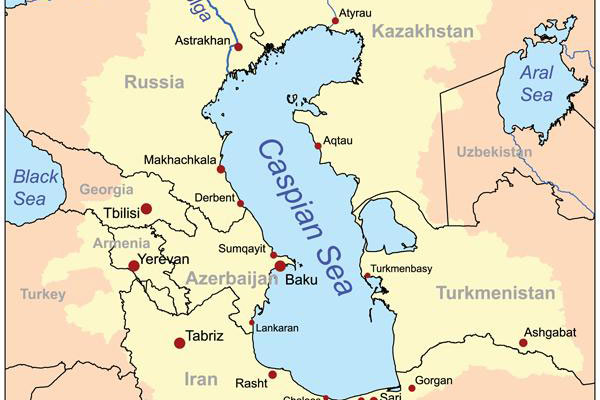Caspian Sea
THE CASPIAN SEA IS ONE of the world's largest bodies of water, situated in a depression between RUSSIA, KAZAKHSTAN, TURKMENISTAN, IRAN, and AZERBAIJAN. It is unique among the world's inland seas in that it is completely isolated from the rest of the global ocean and has a distinctive continental climate which gives the area extremes in temperature, from very hot summers to very cold winters.
Several rivers flow into the Caspian Sea, most notably the VOLGA and the Ural in the far north and the Terek, Sulak and Kura rivers from Daghestan and the Caucasus to the west. In fact, by including the entire Volga River Basin, the Caspian has the largest catchment area in Europe (1.4 million square mi or 3.5 million square km). But no rivers flow out of the Caspian, and most of the water is lost through evaporation. This is aided by the fact that much of the Caspian is very shallow, particularly in the north and the east. These parts are also very low-lying: The lowest point in Europe is the surface of the Caspian Sea, 89 ft (27 m) below sea level. Most of the eastern coast of the Caspian Sea is dry, with the extreme southeastern corner leading directly onto the Kara Kum Desert. In contrast, the southern and western shores are more steep, culminating in the nearly vertical walls along the southern coast where the ELBURZ and Talysh mountains of Iran come down to the sea. The seafloor drops most dramatically in this region as well, with the Caspian's greatest depths over 3,300 ft (1,000 m). The southwestern areas are also mountainous, consisting of the easternmost reaches of the CAUCASUS mountain ranges.

The Caspian stretches for over 620 mi (1,000 km) from north to south, and between 125 and 250 mi (200 and 400 km) east to west, totaling 143,270 square mi (393,000 square km) in area. It holds much of the world's lacustrine (lake-associated) water: 18,881 cubic mi (78,700 cubic km) of mixed salty and brackish fresh water. The salinity of the Caspian is heavily dependent on the level of flow from the Volga.
WORLD'S CAVIAR SUPPLY
Sea life in the Caspian has mostly been cut off from other marine populations for millions of years, though recently there has been some colonization of Mediterranean species via the Don-Volga Canal. Most famous of the Caspian fish are its sturgeon (90 percent of the world's catch), prized for their caviar.
The Caspian is also home to large populations of seals, which are also hunted for their furs. The Caspian was the first place to begin marine extraction of oil and is now one of the most carefully examined regions of the world for future potential in oil and natural gas, particularly in the sandy lowlands and the Mangyshlak and Cheleken peninsulas along the eastern coast.
The eastern coast is marked by several deep inlets and bays, most of which are very shallow. When waters from these bays evaporate, significant valuable chemical compounds are left behind. The world's largest deposits of sodium sulfates are in the basin of the Kara-Bogaz-Gol Bay in Turkmenistan. This bay is considered the world's largest lagoon, as it is mostly cut off from the main body of water by sand bars.
At the height of the Soviet era, this seal was made complete and the bay completely disappeared (a disappearance of several thousand square kilometers of water). But extraction of chemical compounds was actually made more difficult than envisioned, and since the 1980s, the project has been reversed, and water is returning to Kara-Bogaz-Gol. Soviet Volga dam projects significantly lowered the levels of the Caspian in general from the 1930s to the 1970s, when environmental damage became too great to continue to be ignored. The Caspian also suffers from pollution, primarily close to industrial centers and oil refineries along the Apsheron Peninsula of Azerbaijan, and its major city, Baku. Other major ports include Astrakhan, Derbent, and the former Soviet naval station at Krasnovodsk, now in Turkmenistan. The most significant Iranian port on the Caspian Sea is the town of Bandar-e Anzali, the center of the Iranian caviar producing industry.